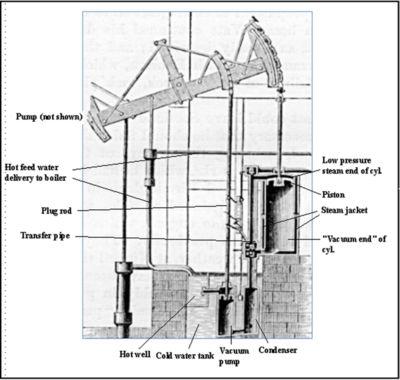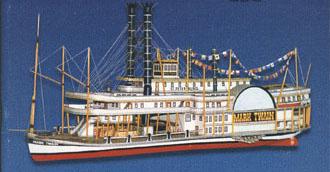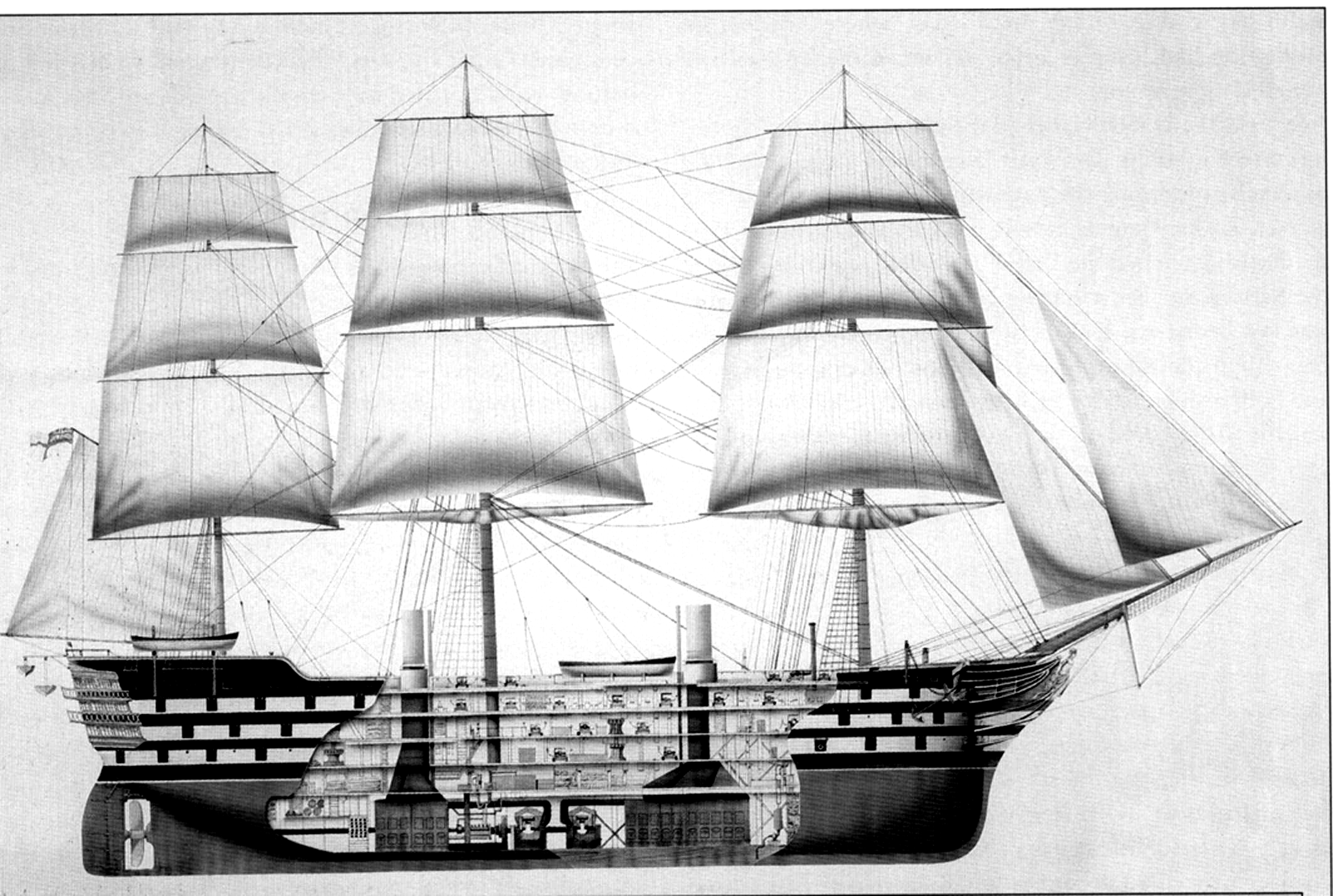
- •Contents
- •Unit I water
- •Text 1a water in human life
- •Text 1b
- •Text 1c
- •Unit II ports
- •Text 2a
- •Text 2b
- •Text 2c
- •Unit III world shipping
- •Text 3a
- •Text 3b
- •Text 3c
- •Unit IV water ecology
- •Vocabulary.
- •Text 4a
- •Text 4b
- •Text 4c
- •Unit V early history of shipbuilding
- •Vocabulary:
- •Text 5a
- •Text 5b
- •Text 5c
- •Unit VI full-riggers
- •Text 6a
- •Text 6b
- •Text 6c
- •Unit VII steam power
- •Text 7b
- •Text 7c
- •Unit VIII great britain as a sea-faring nation
- •Text 8a
- •Text 8b
- •Text 8c
- •Supplemantary texts
- •Abbreviations
- •Geographical and proper names
- •Vocabulary
Unit VII steam power
Ex. 1. Read and remember the words:
Marquis, nobleman, tug, scrap, paddle wheel, paddleboat, draft, vulnerability, lack, bay, voyage, cord, timber, cylinder, piston, stroke, condenser, turbine, heavy oil fuel, motorship, submarine, furnace, aids, hand, essence, combustion, nozzle;
Run (out), rock; stick (out), bite (into), puff, undergo, convert, emphasize, staff, ignite;
Scarce, spectacular, extensive, fragile, subsequent, entire; consecutive; compound, magnificent.
Ex.2. Insert the right word:
Voyage, scarce, vulnerability, bay, draft, bit, undergo, rocked, lack, timber, spectacular, paddleboats, puffing, fragile, turbines, staffed, emphasize, motorships, converts, aids, heavy oil fuel, magnificent, essence, hands, ran out.
1. This … is a convenient site for constructing a harbor. 2. The yard is a sort of … . 3. … were the favourite river transport of the XIXth century. 4. The … of the material is that it is rather … and can’t … physical loads. 5. The traveler couldn’t continue his … because he … … of money. 6. The axe blade … into the tree. 7. The … of your project is in its complexity, though the idea is … . 8. The … of the ship was too deep and it hit the rock. 9. He is an extremely honest man – such people are … nowadays. 10. The storm was terrible and the ship was being … heavily but the captain was … with his pipe as nothing was happening. 11. This device … heat into work. 12. The captain ordered: “All … on deck!” 13. Unlike the steamships the … use … … … instead of coal. 14. A ship equipped with … could show a … speed. 15. It is important to … the fact that you will be given all the necessary … for your work. 16. Sorry, but I can’t get the … of the problem. 17. The enterprise is completely … with personnel.
Ex. 3. Change the words of italic type with their synonyms from your active vocabulary:
1. The whole world knows the names of famous travelers. 2. The ship machine was out of order and the captain had to ask for a tow. 3. A paddle-wheeled steamboat was smoking along the river. 4. The trip was really impressive! 5. You must be careful! The material is rather brittle. 6. In case of an accident a number of successive actions should be taken. 7. The expedition spent all their supplies and further route appeared to be impossible. 8. The ship has a notable forward set. 9. When the vessel moves at a full speed, its propeller actually cuts into the water. 10. Iron-and-steel waste can be used for re-melting. 11. After steamboats had replaced riggers, the shipbuilding experienced considerable changes. 12. When engines with two cylinders began to use, such type of engines was called combined. 13. What additional means can be suggested in case of an accident? 14. Your idea is really brilliant! 15. You can transform one matter to another in the result of this reaction. 16. To produce more steam you had to put more coal into the fire-chamber. 17. The crew was completely manned with sailors. 18. Let us stress this important point once more.
Ex. 4. Define in one word:
-
a man who was born in an aristocratic family;
-
ready to break easily;
-
a steamship driven by paddle wheels;
-
sea travelling;
-
a ship aimed to pull another vessel;
-
broken pieces of metal used for remelting;
-
something which goes one after another;
-
a body of water cut into the shoreline;
-
the level to which a ship is submerged into the water;
-
something taken in a whole;
-
a piston movement;
-
to change one into another;
-
some additional devices to make the work easier;
-
brilliant or excellent;
-
an underwater vessel;
-
a device for burning coal to get heat or to transform it into energy.
Ex. 5. Translate into Russian:
development of the steam engine
to construct an engine himself
the first all-iron steamship
a gifted naval architect
to depend on the muscles of rowers
an overnight stop
to propel the ships
side paddle wheels
to attract enough customers
huge operating costs
suitable for many kinds of work
shallow draft
a French nobleman
means of communication
transatlantic telegraph cable
the ocean floor
an American inventor
to make an ocean voyage
the first workable steamboat
under perfect conditions
to be sold for scrap
a passenger liner
passenger and freight service
entire fuel supply
commercial vessels
regularly scheduled service
in calm waters
in rough seas
commercially successful
iron seagoing ships
the mechanical drive
to support a course
a side-wheeler
all-weather ships
from side to side
wholly under the water
consecutive evolutionary changes
to keep operating
new sources of power
to replace coal as a fuel
stabilization of the hull
one-cylinder steam engine
nuclear-powered ship
a full stroke
impractical for commercial use
compound steam engine
high building and operating costs
to push the piston
floating hotels
the same amount
deck and engine room hands
cut the use up to 50 per cent
chiefly for economic reasons
technological complexity
a marine steam turbine
with minimum labour
luxury liners
to require much less space
Ex. 6. Read and translate the text:
T

FIRST STEAMBOATS
The invention and development of the steam engine revolutionized water transportation. People no longer had to depend on the muscles of rowers or uncertain wind to propel their ships. In 1769, James Watt, a Scottish engineer, patented a steam
Pic. 20. The major components of a Watt pumping engine.
engine that was suitable for many kinds of work. Inventors in Europe and the US soon tried to use it to power boats.
As
it has already been mentioned above, the first steamboats appeared
in late 1700’s. In 1783, the Marquis Claude de Jouffroy d’Abbans,
a French nobleman, built a steamboat that made a 15-minute trip on
the Saone River Pic.
21. Stern-paddle Steamer
near Lyons. But he was never
able to repeat his success. In 1787, John Fitch, an American
inventor, demonstrated the first workable steamboat in the United
States. Its engine powered a series of paddles on e

The beginning of the XIXth century was marked by construction of the first commercial vessels with steam machines.

Such paddleboats were widely spread in the XIX and till the beginning of the XX centuries. They could be used on practically all the significant rivers, because of their shallow draft. In particular, river steamboats with paddle wheels had been the only means of communication on such rivers as the Volga and the Mississippi for about 100 years. It was the paddleboat that allowed to provide a high level of passenger comfort and service and to create a new branch of tourism – cruises.
B

The age of steam began.
*1 cord = 128 ft³
Ex.7. Answer the questions:
1. Why was the invention and development of steam engine so important for water transportation? 2. Who is considered to be the inventor of steam engine? 3. What can you say about the first steamboat? 4. Why did the first American steam vessel projects fail? 5. Who can be called “the father” of the first commercially successful steamboat? 6. What were the reasons of such long popularity of paddleboats? 7. What was the main disadvantage of Fulton’s ships? 8. How did the first ocean-going steamship look like? 9. What country suggested regularly scheduled service across the Atlantic under steam power?
Ex. 8. Agree or disagree with the following statements. Give grounds to your answer:
1. James Watt designed his engine especially for water vessels. 2. The first steamboat was built in France. 3. People accepted the new mean of water transportation at once. 4. Designing his ship, Robert Fulton invented the engine of a new type. 5. One of the main reasons for steam vessels’ popularity was the high rate of passenger comfort. 6. Fulton’s side-wheelers suited both for river and ocean traveling. 7. Paddleboats were much faster than riggers. 8. The first ocean-going steamships were a combination of steam and sailing vessel.
Ex. 9. Translate into English:
1. Изобретение парового двигателя произвело революцию в экономике. 2. Этот прибор подходит для разнообразной работы. 3. Ему никогда не удастся повторить свой рекорд! 4. Первые коммерческие паровые суда начали строить в начале 19-го века. 5. Фултон не стал изобретать новый вид двигателя, а приспособил к своей лодке двигатель Ватта. 6. Путешествие займет около 40 часов, включая остановку на ночь. 7. Из-за неглубокой осадки колесные пароходы лучше подходили для речных, а не морских путешествий. 8. Первые морские пароходы были в действительности парусниками с полным вооружением, дополнительно оснащенными боковыми гребными колесами с паровым приводом.
Ex. 10. Define the main topic and idea of the text, split it into the logical parts, make up the plan of the text.
Ex. 11. Abstract the text.
Ex. 12. Read and try to understand the text, looking the comments below:
